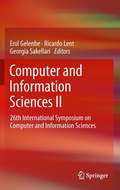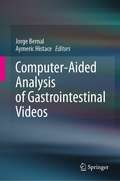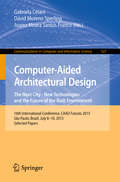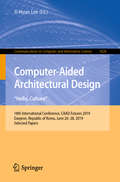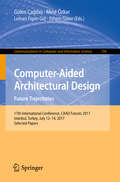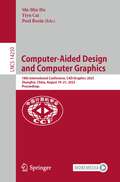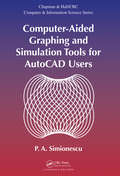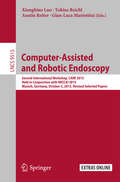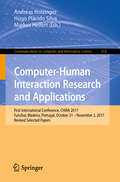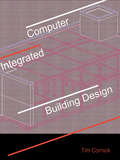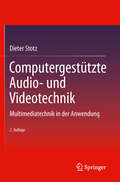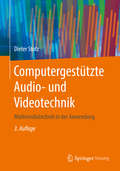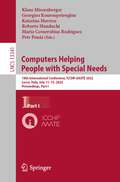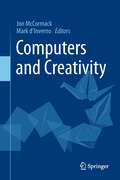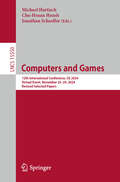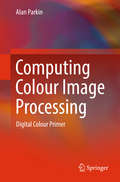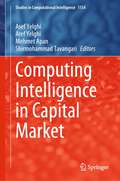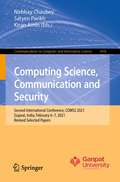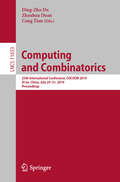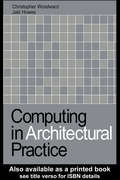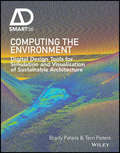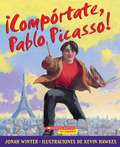- Table View
- List View
Computer and Information Sciences II: 26th International Symposium on Computer and Information Sciences
by Erol Gelenbe Ricardo Lent Georgia SakellariInformation technology is the enabling foundation for all of human activity at the beginning of the 21st century, and advances in this area are crucial to all of us. These advances are taking place all over the world and can only be followed and perceived when researchers from all over the world assemble, and exchange their ideas in conferences such as the one presented in this proceedings volume regarding the 26th International Symposium on Computer and Information Systems, held at the Royal Society in London on 26th to 28th September 2011. Computer and Information Sciences II contains novel advances in the state of the art covering applied research in electrical and computer engineering and computer science, across the broad area of information technology. It provides access to the main innovative activities in research across the world, and points to the results obtained recently by some of the most active teams in both Europe and Asia.
Computer-Aided Analysis of Gastrointestinal Videos
by Jorge Bernal Aymeric HistaceThis book opens with an introduction to the main purpose and tasks of the GIANA challenge, as well as a summary and an analysis of the results and performance obtained by the 20 participating teams. The early and accurate diagnosis of gastrointestinal diseases is critical for increasing the chances of patient survival, and efficient screening is vital for locating precursor lesions. Video colonoscopy and wireless capsule endoscopy (WCE) are the gold-standard tools for colon and intestinal tract screening, respectively. Yet these tools still present some drawbacks, such as lesion miss rate, lack of in vivo diagnosis capabilities, and perforation risk. To mitigate these, computer-aided detection/diagnosis systems can play a key role in assisting clinicians in the different stages of the exploration.This book presents the latest, state-of-the-art approaches in this field, and also tackles the clinical considerations required to efficiently deploy these systems in the exploration room. The coverage draws upon results from the Gastrointestinal Image Analysis (GIANA) Challenge, part of the EndoVis satellite events of the conferences MICCAI 2017 and 2018. Each method proposed to address the different subtasks of the challenges is detailed in a separate chapter, offering a deep insight into this topic of interest for public health.This book appeals to researchers, practitioners, and lecturers spanning both the computer vision and gastroenterology communities.
Computer-Aided Architectural Design Futures. The Next City - New Technologies and the Future of the Built Environment: 16th International Conference, CAAD Futures 2015, São Paulo, Brazil, July 8-10, 2015. Selected Papers (Communications in Computer and Information Science #527)
by Gabriela Celani David Moreno Sperling Juarez Moara Santos FrancoThis book constitutes the refereed proceedings of the 16th International Conference on Computer-Aided Architectural Design Futures, CAAD Futures 2015, held in São Paulo, Brazil, in July 2015. The 33 revised full papers presented were carefully reviewed and selected from 200 submissions. The papers are organized in topical sections on modeling, analyzing and simulating the city; sustainability and performance of the built space; automated and parametric design; building information modelling (BIM); fabrication and materiality; shape studies.
Computer-Aided Architectural Design. "Hello, Culture": 18th International Conference, CAAD Futures 2019, Daejeon, Republic of Korea, June 26–28, 2019, Selected Papers (Communications in Computer and Information Science #1028)
by Ji-Hyun LeeThis book constitutes selected papers of the 18th International Conference on Computer-Aided Architectural Design Futures, CAAD Futures 2019, held in Daejeon, Republic of Korea, in June 2019. The 34 revised full papers presented were carefully reviewed and selected from 194 submissions. The papers are organized in topical sections on theory, methodology and practice of architectural and interior design; support systems for design decisions; tools, methods and implementation of urban design; rethinking space and spatial behavior; fabrication and materialization; and shape studies.
Computer-Aided Architectural Design. Future Trajectories
by Gülen Çağdaş Mine Özkar Leman Figen Gül Ethem GürerThis book constitutes selected papers of the 17th International Conference on Computer-Aided Architectural Design Futures, CAAD Futures 2017, held in Istanbul, Turkey, in July 2017. The 22 revised full papers presented were carefully reviewed and selected from numerous submissions. The papers are organized in topical sections on modeling urban design; support systems for design decisions; studying design behavior in digital environments; materials, fabrication, computation; shape studies.
Computer-Aided Design and Computer Graphics: 18th International Conference, CAD/Graphics 2023, Shanghai, China, August 19–21, 2023, Proceedings (Lecture Notes in Computer Science #14250)
by Paul Rosin Yiyu Cai Shi-Min HuThis book constitutes the proceedings of the CCF 18th International Conference on Computer-Aided Design and Computer Graphics, CAD/Graphics 2023, which took place in Shanghai, China, during August 19–21, 2023.The 23 full papers included in this book were carefully reviewed and selected from 169 submissions. They focus on topics such as computer graphics and CAD, 3D Printing and Computational Fabrication, 3D Vision, Bio-CAD and Nano-CAD, Computer Animation, Deep Learning for Graphics, Geometric Modeling, Geometry Processing, Rendering, Virtual Reality, Augmented Reality, Visualization, and more.
Computer-Aided Graphics and Design (Computer Aided Engineering Ser. #4)
by Daniel L. RyanThis text, now in its third edition, presents all common methods of computer/automated graphical construction most helpful to the engineering student, draftsperson or designer, describing, in easy-to-understand terms, a wide range of hardware platforms that will run a single set of software options from the Autodesk Corporation. Rewritten and illustrated with over 330 tables, drawings and photographs, this is a vital reference for all mechanical, electrical and electronics, manufacturing, software, civil and architectural engineers; engineering designers and drafters, and industrial illustrartors and asrtisits. A defintive text on the subject for students familiar with LISP in undergarduate courses.
Computer-Aided Graphing and Simulation Tools for AutoCAD Users
by P. A. SimionescuThis book allows readers to expand the versatility of AutoCAD design and documentation software. It provides ready-to-use procedures and computer programs for solving problems in a variety of application areas, including computer-aided design, data visualization, evolutionary computation, numerical methods, single and multicriteria optimization, li
Computer-Assisted and Robotic Endoscopy: Second International Workshop, CARE 2015, Held in Conjunction with MICCAI 2015, Munich, Germany, October 5, 2015, Revised Selected Papers (Lecture Notes in Computer Science #9515)
by Xiongbiao Luo Tobias Reichl Austin Reiter Gian-Luca MariottiniThis book constitutes the thoroughly refereedpost-conference proceedings of the Second International Workshop on ComputerAssisted and Robotic Endoscopy, CARE 2015, held in conjunction with MICCAI2015, in Munich, Germany, in October 2015. The 15 revised full papers were carefully selected out of20 initial submissions and focus on recent technical advances associated withcomputer vision; graphics; robotics and medical imaging; external trackingsystems; medical device control systems; information processing techniques;endoscopy; planning and simulation.
Computer-Human Interaction Research and Applications: First International Conference, CHIRA 2017, Funchal, Madeira, Portugal, October 31 – November 2, 2017, Revised Selected Papers (Communications in Computer and Information Science #654)
by Andreas Holzinger Markus Helfert Hugo Plácido SilvaThis book constitutes the refereed proceedings of the First International Conference on Computer-Human Interaction Research and Applications, CHIRA 2017, held in Funchal, Madeira, Portugal, in October/November 2017.The 8 full papers presented in this book were carefully reviewed and selected from 35 submissions. The papers selected to be included in this book contribute to the understanding of relevant trends of current research on computer-human interaction, including Interaction design, human factors, entertainment, cognition, perception, user-friendly software and systems, pervasive technologies and interactive devices.
Computer-Integrated Building Design
by Tim CornickComputer-Integrated Building Design is an accessible guide to the principles and applications of computer-integrated systems as applied to construction management. It describes current research, development and application of CAD related tools and techniques to the building design process and demonstrates the methods necessary to achieve knowledge-sharing in building design.
Computergestützte Audio- und Videotechnik: Multimediatechnik in der Anwendung
by Dieter StotzDiese Einführung in die moderne Audio- und Videotechnik ermöglicht Lesern mit technischem Grundverständnis einen leichten Einstieg - auch in komplexe Zusammenhänge. Der Autor vermittelt detailliertes Wissen, praxisnah und verständlich aufbereitet: von den Grundlagen der Ton- und Videotechnik über Abtastung und Digitalisierung, räumliches Hören, Datenkompression, MIDI-Standard und -Signale, digitale Audiomesstechnik bis zu hochauflösender Videotechnik, Genlock, Chromakeying, Schnittsystemen und Animation. Mit vielen Graphiken und Abbildungen.
Computergestützte Audio- und Videotechnik: Multimediatechnik in der Anwendung
by Dieter StotzDiese Einführung in die moderne Audio- und Videotechnik ermöglicht Lesern mit technischem Grundverständnis einen leichten Einstieg – auch in komplexe Zusammenhänge. Der Autor vermittelt detailliertes Wissen, praxisnah und verständlich aufbereitet: von den Grundlagen der Ton- und Videotechnik über Abtastung und Digitalisierung, räumliches Hören, Datenkompression, MIDI-Standard und -Signale, digitale Audiomesstechnik bis zu hochauflösender Videotechnik, Genlock, Chromakeying, Schnittsystemen und Animation. Mit vielen Graphiken und Abbildungen.
Computers Helping People with Special Needs: 18th International Conference, ICCHP-AAATE 2022, Lecco, Italy, July 11–15, 2022, Proceedings, Part I (Lecture Notes in Computer Science #13341)
by Roberto Manduchi Klaus Miesenberger Mario Covarrubias Rodriguez Georgios Kouroupetroglou Katerina Mavrou Petr PenázThe two-volume set LNCS 13341 and 13342 constitutes the refereed proceedings of the Joint International Conference on Digital Inclusion, Assistive Technology, and Accessibility, ICCHP-AAATE 2022. The conference was held in Lecco, Italy, in July 2022.The 112 papers presented were carefully reviewed and selected from 285 submissions. Included also are 18 introductions. The papers are organized in the following topical sections: Part I: Art Karshmer Lectures in Access to Mathematics, Science and Engineering; Digital Solutions for Inclusive Mobility: solutions and accessible maps for indoor and outdoor mobility; implementation and innovation in the area of independent mobility through digital technologies; haptic and digital access to art and artefacts; accessibility of co-located meetings; interactions for text input and alternative pointing; cognitive disabilities and accessibility; augmentative and alternative communication (AAC): emerging trends, opportunities and innovations; language accessibility for the deaf and hard-of-hearing. Part II: Digital accessibility: readability and understandability; serious and fun games; internet of things: services and applications for people with disabilities and elderly persons; technologies for inclusion and participation at work and everyday activities; robotic and virtual reality technologies for children with disabilities and older adults; development, evaluation and assessment of assistive technologies; ICT to support inclusive education – universal learning design (ULD); design for assistive technologies and rehabilitation; assistive technologies and inclusion for older people.
Computers Of Star Trek
by Lois H. Gresh Robert WeinbergThe depiction of computers on the various "Star Trek" series has ranged from lame to breathtakingly imaginative. This book covers the gamut, and makes lucid and entertaining comparison of these fictional computers with those that now exist or are likely to inhabit our future. Throughout its history, "Star Trek" has been an accurate reflection of contemporary ideas about computers and their role in our lives. Affectionately but without illusions, The Computers of Star Trek shows how those ideas compare with what we now know we can and will do with computers.
Computers and Creativity
by Jon Mccormack Mark D’invernoThis interdisciplinary volume introduces new theories and ideas on creativity from the perspectives of science and art. Featuring contributions from leading researchers, theorists and artists working in artificial intelligence, generative art, creative computing, music composition, and cybernetics, the book examines the relationship between computation and creativity from both analytic and practical perspectives. Each contributor describes innovative new ways creativity can be understood through, and inspired by, computers. The book tackles critical philosophical questions and discusses the major issues raised by computational creativity, including: whether a computer can exhibit creativity independently of its creator; what kinds of creativity are possible in light of our knowledge from computational simulation, artificial intelligence, evolutionary theory and information theory; and whether we can begin to automate the evaluation of aesthetics and creativity in silico. These important, often controversial questions are contextualised by current thinking in computational creative arts practice. Leading artistic practitioners discuss their approaches to working creatively with computational systems in a diverse array of media, including music, sound art, visual art, and interactivity. The volume also includes a comprehensive review of computational aesthetic evaluation and judgement research, alongside discussion and insights from pioneering artists working with computation as a creative medium over the last fifty years. A distinguishing feature of this volume is that it explains and grounds new theoretical ideas on creativity through practical applications and creative practice. Computers and Creativity will appeal to theorists, researchers in artificial intelligence, generative and evolutionary computing, practicing artists and musicians, students and any reader generally interested in understanding how computers can impact upon creativity. It bridges concepts from computer science, psychology, neuroscience, visual art, music and philosophy in an accessible way, illustrating how computers are fundamentally changing what we can imagine and create, and how we might shape the creativity of the future. Computers and Creativity will appeal to theorists, researchers in artificial intelligence, generative and evolutionary computing, practicing artists and musicians, students and any reader generally interested in understanding how computers can impact upon creativity. It bridges concepts from computer science, psychology, neuroscience, visual art, music and philosophy in an accessible way, illustrating how computers are fundamentally changing what we can imagine and create, and how we might shape the creativity of the future.
Computers and Games: 12th International Conference, CG 2024, Virtual Event, November 25-29, 2024, Revised Selected Papers (Lecture Notes in Computer Science #15550)
by Jonathan Schaeffer Michael Hartisch Chu-Hsuan HsuehThis book constitutes the refereed proceedings of the 12th International Conference on Computers and Games, CG 2024, held as a virtual event, during November 25-29, 2024. The 17 full papers included in this book were carefully reviewed and selected from 40 submissions. They are organized in the following topical sections: Chess and its Variants; Go and NoGo; General Approaches for Solving and Playing Games; Nonograms; Social Aspects of Games; and Games with Uncertainty.
Computers in Broadcast and Cable Newsrooms: Using Technology in Television News Production (Routledge Communication Series)
by Phillip O. KeirsteadComputers in Broadcast and Cable Newsrooms: Using Technology in Television News Production takes readers through the use of computers and software in the broadcast/cable newsroom environment. Author Phillip O. Keirstead began writing about television news technology decades ago in an effort to help television news managers cope with technological change. In this text, he demonstrates the myriad ways in which today's journalism is tied to technology, and he shows how television news journalists rely on varied and complex technologies to produce timely, interesting, and informative broadcasts. Using a hands-on, practical approach to cover the role computers play in various parts of the newsroom, the volume will be of great practical value to undergraduate and graduate students in advanced broadcast/news television courses.
Computing Colour Image Processing: Digital Colour Primer (SpringerBriefs in Applied Sciences and Technology)
by Alan ParkinThis book proposes a new approach to colour in digital images, based on the standard sRGB colour space and Python scripting. It covers creating, storing, processing, displaying, printing, and viewing colour images. The fundamental ideas presented include systematic reduction of colour resolution to manageable sRGB sub-spaces, analysis of any image as a tabular colour scheme, general transformation and specific substitution of colours, and revival of the traditional notion of a neutral balance by adjusting all colours or by adjoining a colour frame. The text includes Python scripts for the processes discussed, downloadable in the e-book. It is of interest to artists, designers, and anyone who works with sRGB colour images.
Computing Intelligence in Capital Market (Studies in Computational Intelligence #1154)
by Asef Yelghi Aref Yelghi Mehmet Apan Shirmohammad TavangariThe book is divided into sections according to the content of the chapters. The first section covers AI concepts with NP and financial issues. The second section covers AI techniques in relation to Fintech issues. The remaining sections are implementation and analysis. As science and technology development and algorithms are widely used in various fields, their influence and development have increased efficiency and productivity. The introduction of algorithms in the financial field has not been an exception to this. In recent years, the growth and development of the financial system have been in sync with the growth of technology. Fintechs were born at the intersection of these two sectors. What happens through the application of computer knowledge in the financial field, or the examination of the efficiency and effectiveness of their use and the interaction and combination of these two fields has been written very infrequently in the majority of books. In Fintech, there are problems that researchers focus on such as customer support, portfolio management, trading algorithms, fraud detection, credit risk assessment, insurance, and wealth management. The mentioned problems are complex and are mapped to NP problems in the field of artificial intelligence. In the last two decades, optimization algorithms, neural networks, and deep learning have been widely applied in many scientific and engineering fields to solve the mentioned problems. The purpose of this book is to provide the reader with the most used artificial intelligence methods for scientific and engineering problems. This book is used by students, scientists, and practitioners in various fields. The chapters are self-explanatory, and the reader can read each one separately. They describe the algorithm used, the chosen problem, and the implementation. In addition, practical examples, comparisons, and experimental results are presented.
Computing Science, Communication and Security: Second International Conference, COMS2 2021, Gujarat, India, February 6–7, 2021, Revised Selected Papers (Communications in Computer and Information Science #1416)
by Nirbhay Chaubey Satyen Parikh Kiran AminThis book constitutes revised selected papers of the Second International Conference on Computing Science, Communication and Security, COMS2 2021, held in Gandhinagar, India, in February 2021. Due to the COVID-19 pandemic the conference was held virtually. The 19 full papers were thoroughly reveiwed and selected from 105 submissions. Papers are organised according to the topical sections on artificial intelligence and machine learning; networking and communications.
Computing and Combinatorics: 25th International Conference, COCOON 2019, Xi'an, China, July 29–31, 2019, Proceedings (Lecture Notes in Computer Science #11653)
by Ding-Zhu Du Zhenhua Duan Cong TianThis book constitutes the proceedings of the 25th International Conference on Computing and Combinatorics, COCOON 2019, held in Xi’an, China, in July 2019. The 55 papers presented in this volume were carefully reviewed and selected from 124 submissions. The papers cover various topics, including algorithm design, approximation algorithm, graph theory, complexity theory, problem solving, optimization, computational biology, computational learning, communication network, logic, and game theory.
Computing in Architectural Practice
by Christopher Woodward Jaki HowesThis book provides a concise introduction for small and medium sized architectural practices considering introducing computers or using them more widely.
Computing the Environment: Digital Design Tools for Simulation and Visualisation of Sustainable Architecture (AD Smart)
by Brady Peters Terri PetersComputing the Environment presents practical workflows and guidance for designers to get feedback on their design using digital design tools on environmental performance. Starting with an extensive state-of-the-art survey of what top international offices are currently using in their design projects, this book presents detailed descriptions of the tools, algorithms, and workflows used and discusses the theories that underlie these methods. Project examples from Transsolar Klimaengineering, Buro Happold´s SMART Group, Behnish Behnisch Architects, Thomas Herzog, Autodesk Research are contextualized with quotes and references to key thinkers in this field such as Eric Winsberg, Andrew Marsh, Michelle Addington and Ali Malkawi.
Compórtate, Pablo Picasso
by Jonah Winter Kevin HawkesFrom Jonah Winter and Kevin Hawkes (both beloved bestsellers and award winners), the story of how Pablo Picasso painted the way he wanted to paint, and left the world speechless! Pablo Picasso may have been one of the most famous artists of the 20th century, but that doesn't mean he painted what people wanted him to paint! In fact, some people hated his paintings! But Picasso didn't listen to all those people, and kept on working the way he wanted to work, until he created something so different. . . that people didn't know what to say! Pablo Picasso puede ser uno de los pintores más famosos del siglo XX, pero eso no quiere decir que él siempre pintó las cosas que los demás querían que pintara. De hecho, algunas personas detestaban sus pinturas. Pero a Picasso no le importaba la opinión de esas personas y se mantuvo pintando lo que él quería hasta llegar a pintar algo tan diferente que la gente no supo qué decir.
